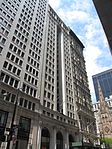Rector Street station (IRT Sixth Avenue Line)
1878 establishments in New York (state)1938 disestablishments in New York (state)Defunct New York City Subway stations located abovegroundFormer elevated and subway stations in ManhattanIRT Sixth Avenue Line stations ... and 3 more
Manhattan railway station stubsRailway stations closed in 1938Railway stations in the United States opened in 1878
Rector Street IRT station was a station on the demolished IRT Sixth Avenue Line in Manhattan, New York City. It had three tracks and two side platforms. It opened on June 5, 1878, served by trains from the IRT Sixth Avenue Line, and was one block east of Rector Street El Station on the IRT Ninth Avenue Line. In 1918, Brooklyn Rapid Transit Company built the Broadway Subway through Manhattan and added a station at Rector Street, which served as competition for the 6th Avenue Line station. The el station closed on December 4, 1938. The next southbound stop was Battery Place on the IRT Ninth Avenue Line. The next northbound stop was Cortlandt Street.
Excerpt from the Wikipedia article Rector Street station (IRT Sixth Avenue Line) (License: CC BY-SA 3.0, Authors).Rector Street station (IRT Sixth Avenue Line)
Rector Street, New York Manhattan
Geographical coordinates (GPS) Address Nearby Places Show on map
Geographical coordinates (GPS)
| Latitude | Longitude |
|---|---|
| N 40.707741666667 ° | E -74.013 ° |
Address
Rector Street
Rector Street
10006 New York, Manhattan
New York, United States
Open on Google Maps








